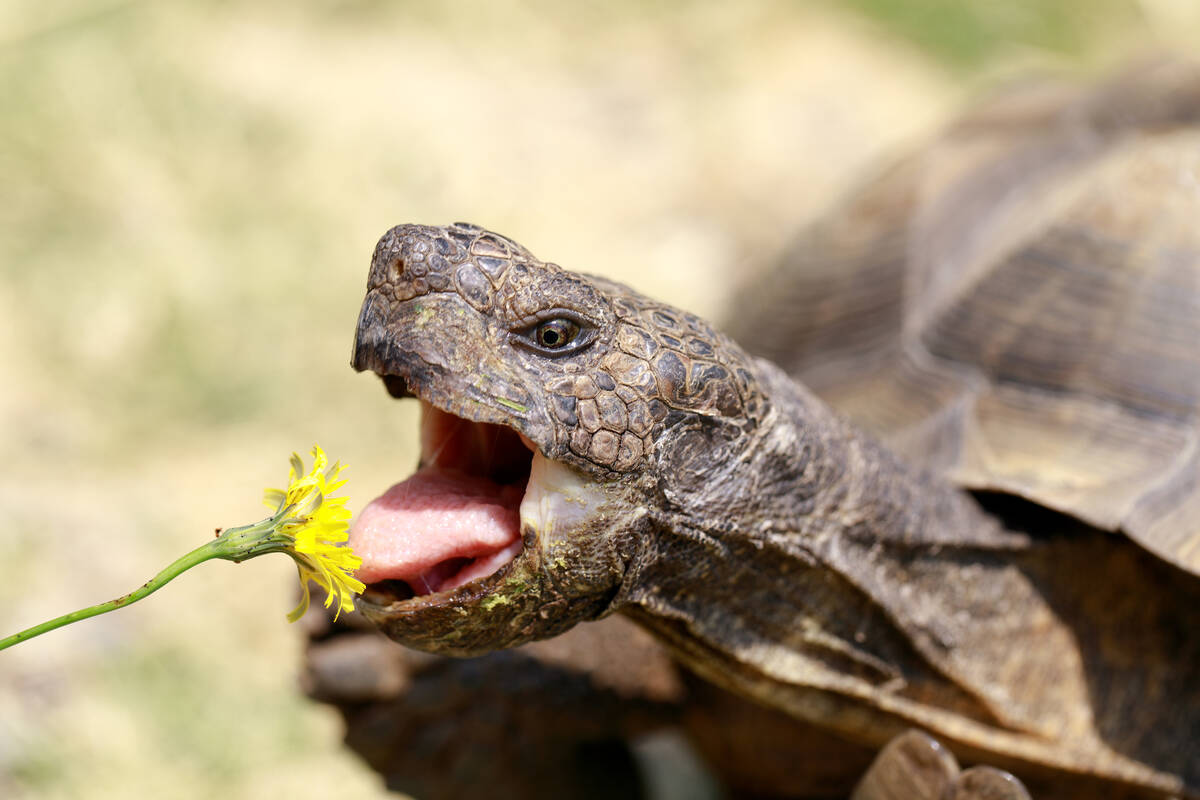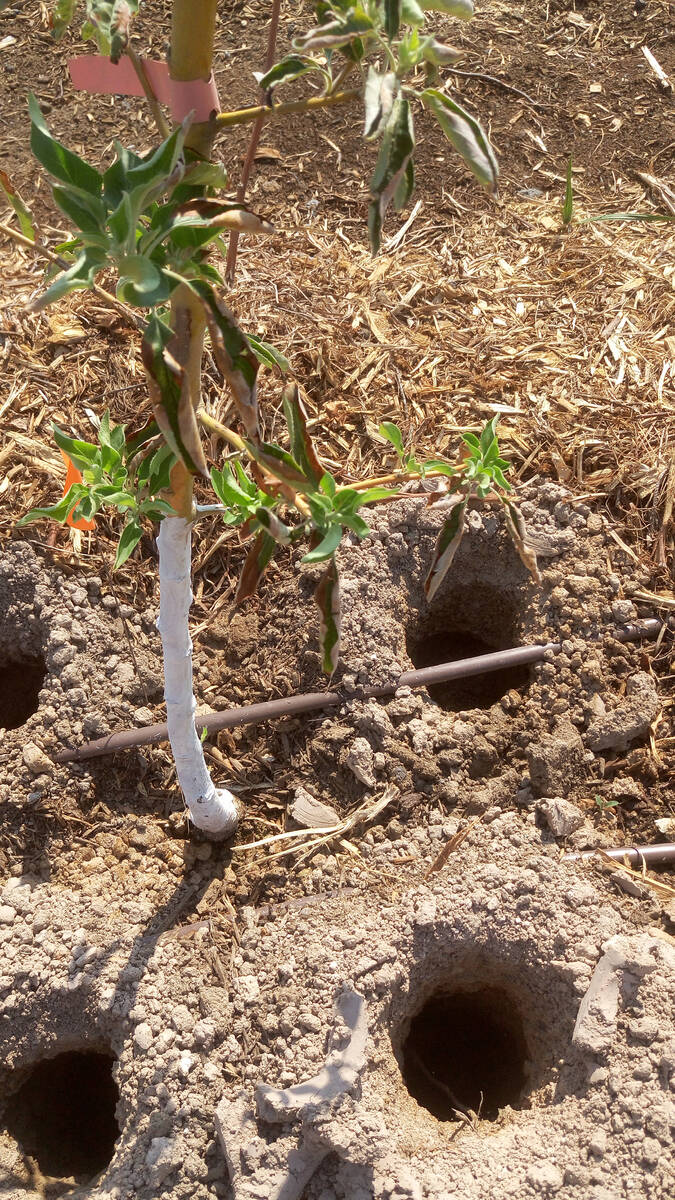Which garden plants can a desert tortoise safely eat?
Q: I have a garden that I want to let my tortoise roam in. What plants do they like and which ones are bad for them?
A: A desert tortoise’s diet should consist of 85 percent grass, weeds and dark, leafy greens, while only 15 percent should be vegetables that you are growing. Fruit can be given as a treat but not regularly.
A pretty high percentage of landscape plants are poisonous to humans. Of course, the amount eaten has a lot to do with it. Right now, there are a lot of weeds growing that are safe to eat such as wild mustards and annual or perennial sowthistle. We may call many of these plants winter annuals even when they aren’t annuals. During the summer you can grow opuntia pads (not cholla cactus), Bermuda grass, alfalfa and many of the native plants that are grassy.
A farm will have timothy now, ryegrass, millet, etc. Stay away from any plants in the tomato family (nightshades), which includes pepper, potato and eggplant. As far as available landscape plants, stay away from oleanders, any of the foxgloves, lantanas, yews or “brooms” of any kind, mountain laurels, jimson weed (sometimes called Datura), any of the hedgehog cactuses, hydrangeas, Virginia creeper, any of the cycads or sago palm.
I made this list from the internet as I didn’t know what was safe for desert tortoises to eat. I was assuming that plants safe to eat for humans were also safe for the desert tortoise; that may or may not be true. Check with a veterinarian to be sure.
Q: We have a healthy, mature Meyer lemon tree. Last year we got over 200 beautiful lemons and this year only about 60, all on the north side of the tree. We have picked about half of them and are wondering if we should remove the rest now before the weather warms and new growth appears. We give lots away and squeeze the rest into ice trays for later use. Also, we’re thinking about trying to make limoncello.
A: Many citrus experts believe that leaving the fruit on the tree interferes with next year’s production of flowers. I would encourage you to harvest them. They will keep a little bit longer in the refrigerator if they are removed from the tree with the pruning shears. Leave the “button” on the fruit covered with part of the stem. Any wounds on the fruit are potential points of infection.
Lemons will keep about four to six weeks after the fruit is harvested and put in the refrigerator. Lemons can also be frozen for up to four months. You can freeze whole lemons, cut lemons, lemon wedges, lemon zest or lemon juice. To freeze lemon slices, you can wash and dry the lemons; cut into slices, rounds or wedges; place on a baking sheet lined with parchment paper; and put the baking sheet in the freezer overnight. Once they’re frozen, remove the lemon slices and put them in a Ziploc bag.
Lemons that have gone bad will feel soft and squishy. They may also have a slimy outer skin, appear shriveled and wrinkled or have a powdered or dusty appearance that’s gray, blue or green in color.
Q: Is it too late to fertilize now? I have oleanders, lantana, rosemary and a chaste tree.
A: No, it’s not. You can fertilize any of the plants you mentioned anytime, either in the spring or the fall or both. Avoid fertilizing anything during the heat of the summer. You can fertilize landscape plants anytime except those plants that are winter-tender. Lantana is winter-tender, but it is normally pruned within 1 inch of the soil surface in early spring.
Avoid giving any plants high nitrogen fertilizers when it starts to get hot and the winter-tender plants the following fall and winter months.
The idea is to avoid stimulating exposed new growth, with high nitrogen fertilizers, that might get damaged by freezing temperatures. The focus is on the landscape plants, not fertilizers. But if you forget, fertilize all landscape plants when you start to see new growth in the spring.
Q: I have a 20-year-old ash tree that was beautiful in previous summers. This spring about 40 percent of it looks dead. Last November, a tree company cut down my neighbor’s ash tree about 5 feet away from this tree. They treated the area with a “stump killer.” I now have some damage to one Texas ranger and a lantana close to this treated area as well. Could this have somehow contaminated the ground or gotten into the roots of the one remaining tree we have?
A: I have to admit, from your description, it does make me suspicious. Without knowing the chemical applied to the stump area, it is difficult to say. There are clear warnings and precautions on labels when using stump killers, particularly when other plants are close. You would need to find out what was used. These precautions are printed on the label. Hopefully this tree company used an approved product and applied it according to the label. Consult with an attorney to judge whether legal action is necessary.
It might be confused with a disease on ash trees called “ash decline,” a relatively common problem on several types of ash trees. Ash decline is a progressive plant disease that can result, over several years, in a 40 percent decline of the tree or death. But ash trees are the only plants affected by this disease. It can also be confused with improper watering. Over the long term, ash trees grow successfully in lawns, but they often decline over the years when surrounded by rock.
You might try flooding the area with water. Sometimes weekly flooding of the area can help. Build a flat moat 3 to 4 inches deep and several feet wide around each of the affected plants. Apply 2 to 3 inches of water inside that moat weekly.
There are no pesticides to correct this kind of problem. The only practice you can do is make sure those infected plants are getting enough water.
Q: I was told that I’m watering my plants too often because of their leaf color. How would you recommend that I water them?
A: If water drains from the area overnight there should be no problem. But if it takes much longer than that, I would do something about it. Never water plants more frequently than every other day during the heat of the summer. When watering, water deep rather than often. Plants up to 5 feet have shallow roots and require watering to a depth of 12 inches. When plants are 5 to 15 feet tall, they are considered medium in height and have roots that grow 12 to 18 inches deep. The important point to remember: As plants get taller, they need more water.
For better drainage, try a technique called vertical mulching. This is drilling holes in the soil about 18 inches from the tree in a square pattern around the trunk by using an auger attached to a drill. These holes are about 3 to 4 inches in diameter, 18 to 24 inches deep and act as a sump for water drainage.
The light-colored leaves are most likely a sign of iron deficiency. In the spring, apply a fertilizer containing iron to darken the leaves.
Bob Morris is a horticulture expert and professor emeritus of UNLV. Visit his blog at xtremehorticulture.blogspot.com. Send questions to Extremehort@aol.com.































